![]()
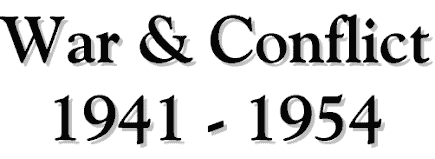
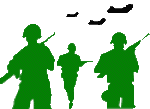 In 1941, Americans could look either east or west and find a shooting war in
progress. Civilians in countries involved in these struggles were dying without even
seeing the flash of an enemy saber or hearing the roar of his cannon. In many corners of
the world, home front and battle front were becoming indistinguishable. In 1941, Americans could look either east or west and find a shooting war in
progress. Civilians in countries involved in these struggles were dying without even
seeing the flash of an enemy saber or hearing the roar of his cannon. In many corners of
the world, home front and battle front were becoming indistinguishable.In the United States, the average citizen was still content to root for Great Britain, France, and the other allies from the sidelines. Although isolationists were now a distinct minority, few Americans were as yet advocating military aid to Europe or China. Congress, too, concentrated on economic rather than military assistance by approving the lend-lease bill - an act that authorized the U.S. to lend or lease weapons, raw materials, facilities, food, or other goods to the nations whose defense was deemed vital to that of the U.S. Then on December 7, 1941, a day that President Franklin Roosevelt predicted would "live in infamy," planes from a Japanese task force struck the U.S. military installations in Hawaii. Caught unaware, the naval base at Pearl Harbor received the brunt of the assault. While sacrificing twenty-eight aircraft and three midget submarines of their own, the Japanese inflicted losses on American forces of nineteen ships, 3000 lives, and uncounted airplanes and vehicles. The following day, the U.S. Congress swiftly declared that a state of war existed between the United States and the Empire of Japan. Two days later, when Japan's allies, Germany and Italy, declared war upon the United States, Congress adopted a resolution declaring that a state of ware also existed with these two nations. Although many members of the VFW would see action on the various battle fronts, the VFW's major contributions to the war effort took place on the home front. The VFW was by now a highly adaptable and versatile organization, and its War Service Commission made sure the organization funneled its efforts wherever they were needed most. As a result, during the early years of World War II, the VFW's programs were mainly directed toward winning the war. Priority was given to recruiting and training manpower, boosting morale, defending the U.S. against enemy attack or sabotage, and other direct support activities. From 1943 on, however, programs became increasingly concerned with obtaining benefits for returning veterans. During the war and afterwards, the VFW continued to prove that it was truly an all-wars, all-services organization. Following the attack on Pearl Harbor, the VFW's first official act was to dispatch Legislative Representative Omar B. Ketchum with a request that Congress provide immediate life insurance coverage to all men in the service. Because the War Risk Insurance Act of World War I had long since expired, many men, both inside the country and overseas, were not covered. Together with fellow VFW member Casey Jones, Ketchum wrote a bill that would award a $5000 life insurance policy to every serviceman and cover his dependents as well. Congressman John McCormick of Massachusetts introduced the bill into Congress, and on the day after Pearl Harbor, Congress approved it. This bill remained in effect until April 19, 1942, when the National Service Life Insurance Act went into force. Even as Ketchum was persuading Congress to enact the insurance legislation, the VFW national organization was offering its services to the U.S. Government. They took on the job of enrolling auxiliary police and firemen. These auxiliary units replaced men who had answered their country's call to the colors, and performed normal police, fire and emergency duties. In some areas, units also provided border patrols whose primary mission was to prevent an invasion by enemy saboteurs. Members from all over the country carried on a recruiting drive and many Post Homes were turned into training centers for auxiliary volunteers.
The VFW had already shown its support for the Air Corps by collecting $150,000 for the purchase of fifteen training planes. Now they established the Aviation Cadet program - a training program to test and drill young men eighteen to twenty-six years of age so they could qualify for the Air Corps. They prepared pamphlets, and supplied tests, aptitude screening material, application blanks, and study materials to more than 1400 Aviation Cadet Committees in forty-six states. Posts then supplied, free of charge, special classes in mathematics, physics, English, geography history, or any other subject in which a recruit was weak. All tests were continually updated to stay abreast of Air Corps requirements. During its seven months of operation, the Aviation Cadet program was extremely effective. In one subject area alone, 83 percent of those who had failed the examination n their first try passed after being tutored by VFW members. In all, the VFW successfully recruited 75,000 men for the Air Corps and 45,000 for other branches of the service. The VFW received hundreds of letters from young fliers thanking the organization for enabling them to "make the grade." Although the Aviation Cadet program, the Americanism Department programs, and other VFW programs conducted at the national level received the most publicity, many worthwhile projects also went on in the trenches (on the local level). Throughout the war, for example, local posts selflessly pitched in to alleviate shortages of materials essential to wartime industry. They could do little about the rationing of consumer goods such as meat, sugar, coffee, canned goods, and cheese which made feeding their members' families difficult, but posts organized and led thousands of scrap drives to feed the demands of industry. Together with other groups and individuals, they helped collect 43,919 tons of fat, 255,513 tons of tin cans, 6 millions tons of waste paper, and 26 million tons of scrap iron and steel. Local Ladies Auxiliaries also devoted themselves to the war effort. Besides assisting posts with local and national programs, Auxiliary members tried to ensure that each serviceman, no matter where he was stationed, received mail from home. Auxiliaries sent Christmas boxes filled with home-baked treats, canned goods, and knitted items. They also mailed hundreds of letters via the Post Office's newly introduced V-Mail - a weight-saving measure that transferred letters to microfilm, then reprinted them on paper upon arrival overseas. In addition, Auxiliaries visited servicemen in veterans' hospitals and sent them homemade baked goods, books, and cigarettes. Thanks to their first-hand knowledge about the way the war was progressing, the VFW's leaders easily recognized when the time was ripe to change from a wartime program to one aimed at handling the postwar problems its veterans would encounter. That turning point came in 1943, when Allied forces went on the offensive in both the European Theater of Operations (ETO) and the Pacific Theater of Operations (PTO) and reclaimed areas such as Stalingrad, Rostov, and Kharkov in Russia; Tunis and Bizerte in North Africa; the Aleutian Islands; and Guadalcanal in the Pacific. Confident that the war would reach a speedy conclusion, the VFW began shifting its emphasis away from winning the war and toward securing benefits for new veterans now, before "the war's over" apathy make their attainment more difficult. Aware that many millions now in their country's military service would have an increased need for rehabilitation, the VFW gave high priority to expanding and overhauling its Rehabilitation Service. In 1931, this Service had taken over several duties from the National Service Bureau, including the responsibilities for handling claims submitted to the government's War Risk Insurance Bureau, Bureau of Pensions, and Bureau of Vocational Training and Rehabilitation. The VFW now went about improving these programs. In 1945, the VFW Rehabilitation Service grew into what many veterans and government employees considered the "best in the world." At times, in fact, the VFW handled as many veterans' claims as all other agencies combined. Revamping the Rehabilitation Service was not the VFW's only accomplishment during this time. In June 1944, Congress passed Public Law 346, the Service Man's Readjustment Act. The Service Man's Readjustment Act, more commonly called the G.I. Bill of Rights, provided veterans of World War II with funds to continue education that was interrupted by the war, or to obtain training or formal education that would improve their ability to secure gainful employment. With the VFW's support, several other important veterans' bills were passed in 1944. Among these was the Mustering Out Pay Act, passed February 3, 1944. This act was intended to reduce some of the economic hardships veterans of other wars had experienced immediately upon returning home. Provisions included payment for unused leave time and transportation to the returnee's home of record, as well as a VFW-backed provision of differential payment for men with foreign service. The final act beneficial to servicemen was the Veteran Preference Law of 1944. Thanks to this law, job preference for veterans no longer had to be granted on a war-by-war basis by regulation, directive, or presidential proclamation; it was now a matter of statue law. In addition, the new federal law allowed returnees - as a step to ease the transition back into civilian life - fifty-two weeks of unemployment compensation at $20 a week. For veterans who wanted to go into business, the government guaranteed half of a $2000 loan bearing a maximum interest charge of 4 percent. In addition, the government helped job-seeking veterans find employment. The VFW's many efforts on behalf of veterans - on the home front, in the legislative arena, in union circles - did not go unremarked. During the war, overseas veterans joined the VFW by the thousands. Between 1940 and 1945, membership increased by more than 350 percent, growing from 201,170 to 741,310. By 1946, a year after Allied victory had been declared first in Germany, then in Japan, membership had climbed to 1,544,444 - the highest level it would reach until 1970. And by 1949, the VFW's 10,000 posts stretched from coast to coast and from Tokyo and Yokohama to Paris and Bremen. For the VFW, looking after the needs of all these new members in peacetime posed a challenge equal to any it had faced in wartime. In the fall of 1945, the VFW Council of Administration met and endorsed a long-range housing program. They sent a telegram to President Truman urging him to make veterans' housing a priority. In May 1946, Congress obliged by passing the Veteran Emergency Housing Act of 1946 (Public Law 388). After wrestling with housing issues in the early postwar period, the VFW turned its attention to a different entitlement problem; adequate medical care for veterans. The VFW's major battle in this area occurred in 1949, following a Presidential Order curtailing VA hospital construction. As vital as the VFW's campaigns for veterans' entitlements such as pensions, medical care, and housing were, they were not the only issues that concerned the organization during this period. The organization also lent its support to broader causes - most important, to world peace. From April 25 to June 26, 1945, representatives of about fifty nations gathered in San Francisco to draw up a charter for the proposed peace organization. The VFW sent a consulting delegation to this United Nations World Conference on International Organization. At about the same time the United Nations charter was being ratified, the VFW held its own version of the United Nations by hosting a United Nations Veterans Victory Conference. At the VFW's invitation, veterans' representatives of twenty-two nations convened to present plans for outlawing future wars. Although its support of the United Nations and its aims were unwavering, the VFW did not relax its stance on military preparedness. As it had since its founding, the organization continued to insist that the best guarantee of peace was a defense force strong enough to enforce that stand. Because of this conviction, in 1946 the VFW established the National Security Committee. The group met regularly with Army and Navy officials on matters of defense and security. In 1950, the "Russian aggression" that the VFW and much of the free world had been condemning, abruptly escalated. At issue was the way in which the tiny Far Eastern nation of Korea had been divided at the end of World War II. The United States had been granted control of the populous, agricultural region south of the 38th parallel, while the Soviet Union had received the sparsely settled, industrial region to the north. With the help of the United Nations, the South Koreans had held elections and drawn up a democratic constitution, but the Northern Koreans remained under the Communists' heel. The Soviets adamantly resisted all attempts by the United States and the United Nations to reunite the sundered nation. Then on June 25, 1950, the North Korean Army made its move. Backed by Russian tanks and planes, the Communists surged across the 38th parallel and invaded the newly formed democracy to the south. American reaction was swift. Within twenty-four hours, President Truman announced he would send the Army and Navy to the aid of South Korea. As the war progressed, the VFW began to find some fault with the Truman administration's handling of the Korean situation. The 13,000 delegates of the August 27 through September 1, 1950 encampment were especially critical of White House policies. They called upon the President to seek out new leadership of the "Highest Integrity and Non-Political Favor" and to develop policies concerning foreign policy and national defense. The delegates passed resolutions asking Congress for: the mobilization of the National Guard; expansion of the Selective Service draft for all males between the ages of eighteen and thirty-five who had no previous military service; establishment of an adequate radar network, supported by an effective Air Force; conversion and expansion on a global scale of America's intelligence operations. Despite the VFW's occasional differences of opinion with the Truman administration, the organization's contributions to the war effort were as unstinting as usual. Some of the VFW's earliest work was aimed at building public support of the fight against Communism by heightening appreciation of the American way of life. While the VFW was supporting the war effort, it was, of course, also looking out for the rights of the servicemen fighting in Korea. In fact, several times during the Korean conflict, the organization had to mobilize to prevent cuts in existing benefits. In 1951 the government attempted to weaken the Veterans Administration by slashing its budget and reassigning the oversight for certain veterans' entitlements to other federal agencies. The VFW's pressure did its job. The control of veterans' affairs remained in the province of the Administrator of Veterans Affairs. Also during this period, Truman administration leaders tried again to make large cuts in the VA budget in the area of veterans' medical care. For three weeks in April, VFW personnel testified to the need for more hospital beds. Thanks to their testimony the cuts were not made. Still, the battle was not won overnight. Both Commander-in-Chief Frank C. Hilton and his successor, James W. Cothran, found much of their time occupied with long and difficult struggles to prevent these cuts. On June 27, 1953, a truce between North and South Korea was finally signed. The fighting had lasted three years to the day. During that period, 5,720,000 Americans had served in Korea, and the United States had sustained 157,530 casualties. Many who survived had crippling injuries and were in need of serious rehabilitation and other assistance. Others - some 500,000 by 1954 - enrolled in the nation's colleges and universities under the GI Bill. They, too, had special employment, housing, and financial needs. Fortunately, many of the programs and much of the machinery required to meet these needs was still in place from the "popular" war, World War II. Wile the VFW worked to help the new veterans readjust to civilian life, it also continued its war on Communism. Its major objection to the Communist party, then as now, was that Communists advocate the overthrow, violent or otherwise, of other governments. This Communist philosophy is incompatible with the purpose of the VFW as stated in Article I of its constitution: "To maintain true allegiance to the Government of the United States of America, and fidelity to its constitution and laws; to foster true patriotism; to maintain and extend the institution of American freedom; and to preserve and defend the United States from all her enemies, whomsoever." As it had for over a quarter of a century, the VFW pressed Congress to outlaw the communist party. Finally, in 1954, Congress passed a law making the Communist party illegal in the U.S. |
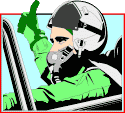 In 1942,
the Army needed fliers badly. It needed a multitude of technicians of all kinds to fill
its rapidly expanding air arm. Unfortunately, thousands of recruits were being turned away
because they could not pass the required exams. To salvage these would-be airmen,
Lieutenant General Henry H. "Hap" Arnold, commanding general of the Army Air
Corps, asked for the VFW's assistance.
In 1942,
the Army needed fliers badly. It needed a multitude of technicians of all kinds to fill
its rapidly expanding air arm. Unfortunately, thousands of recruits were being turned away
because they could not pass the required exams. To salvage these would-be airmen,
Lieutenant General Henry H. "Hap" Arnold, commanding general of the Army Air
Corps, asked for the VFW's assistance.
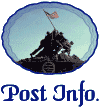


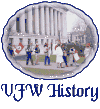




 E-Mail
E-Mail